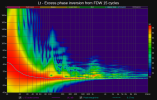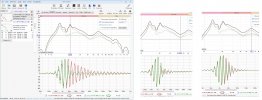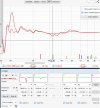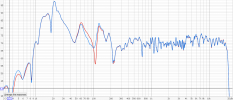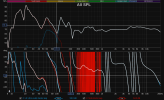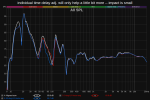AudioBoy
Member
- Joined
- Jan 23, 2023
- Messages
- 66
- Likes
- 34
- Thread Starter
- #61
When I bought the subs I adjusted their phase to best match the main speakers. By measuring the sub separately from the main speaker, you can see that the frequency response of the sub does not change in the area for which it is responsible.If your subs and speakers are out of time you can get dips because they are cancelling each other at those frequencies (like comb filtering). You don't fix it by trying to "overpower" it. You fix it by time/phase aligning them.
RME ADI 2 DAC FS -> XLR -> Neumann KH 750 (L) -> XLR -> Topping LA90 (L) -> Dynaudio Contour 2.0i (L)So how exactly is your system connected? You mentioned RME Babyface Pro, so if you have that connected via XLR to the subwoofer, then the RME is controlling the volume.
_____________________-> XLR -> Neumann KH 750 (R) -> XLR -> Topping LA90 (R) -> Dynaudio Contour 2.0i (R)
I'm using Babyface Pro for measurements only.
Yes, sirDo you have 1 channel to 1 sub to 1 speaker?
YesSo by remote control mode you mean with an app? And manual is with the switches?
I know this and of course change these settings accordingly.But do you still have the "Control Mode" switch set to "Local"?
It controls sub bypass mode. Signal transferred to main speaker at full range and sub does not play anything.I'm not sure what the "Bass Management" switch does either.
This is sufficient because the main speaker is on a stand that sits on top of the subwoofer.only get up to 315° at 80Hz, which is only 11msec, which might not be enough?
it's very easy using sub bypass mode. So no problemBut I'm not sure how you will achieve this considering the speakers signal comes from the sub?
The Remote Control App has Base Management button also, so yes, it's possible.Or maybe you can mute the subs in the app, but still let the speakers play?
Only The Remote Control App has that option but I don't use it because there is no need to compensate for microseconds.which shows that "Digital Delay" can be set, but who knows how?
more info about the app
Today I tested the THD level of the subwoofer in local and network mode and got some interesting results.
I noticed that the curvature of the straight section of the transient response directly depends on the volume of the signal supplied to the subwoofer.
Babyface Pro Settings
REW using ASIO driver from RME.
No FIR filters were used.
Subwoofer settings in Local mode does not changed. (94dB, 0 phase degree, subwoofer gain ~ -6dB, low cut - 0 (off), stereo mode using single channel, 80Hz crossover)
Subwoofer settings in Network mode the same as in local except gain which is 0dB. HiPass and LoPass filter at 80 Hz.
The THD will be better if I lower the volume, the current THD is already the best I can get I guess.
I noticed that the curvature of the straight section of the transient response directly depends on the volume of the signal supplied to the subwoofer.
For more info please download mdat.
To be continued...
Last edited:

